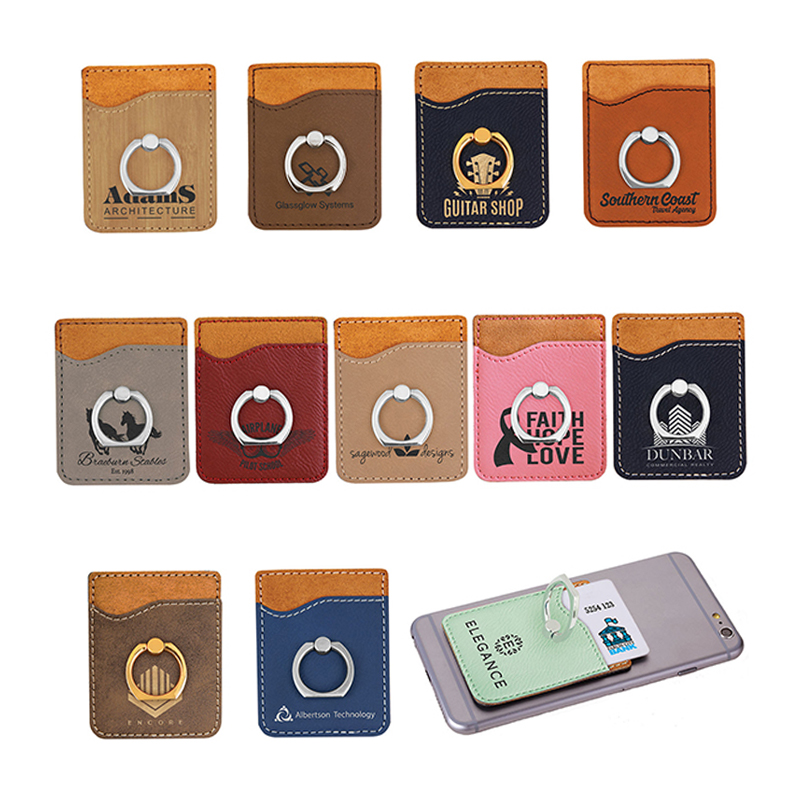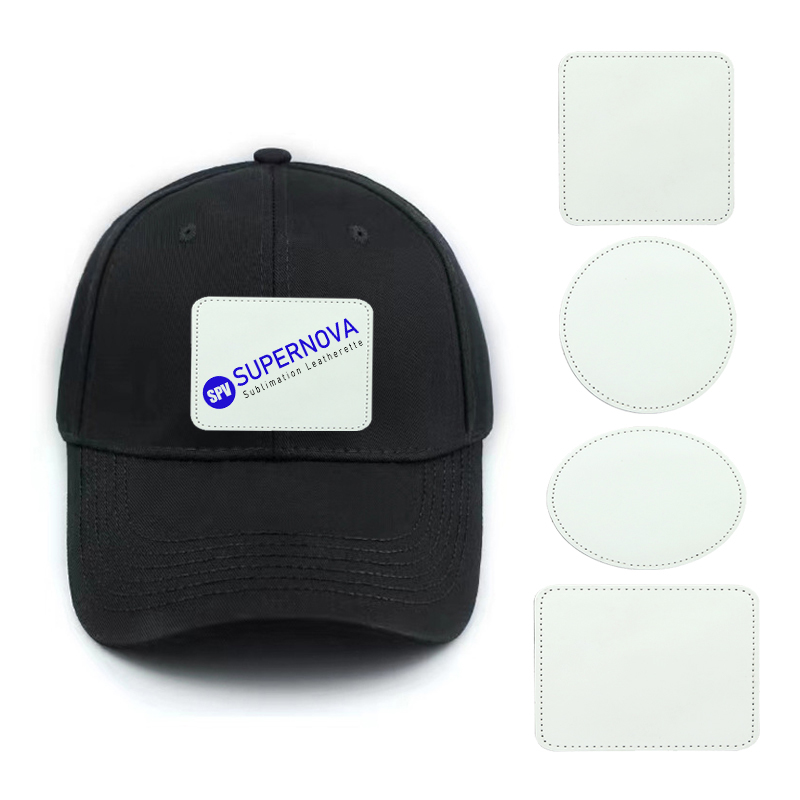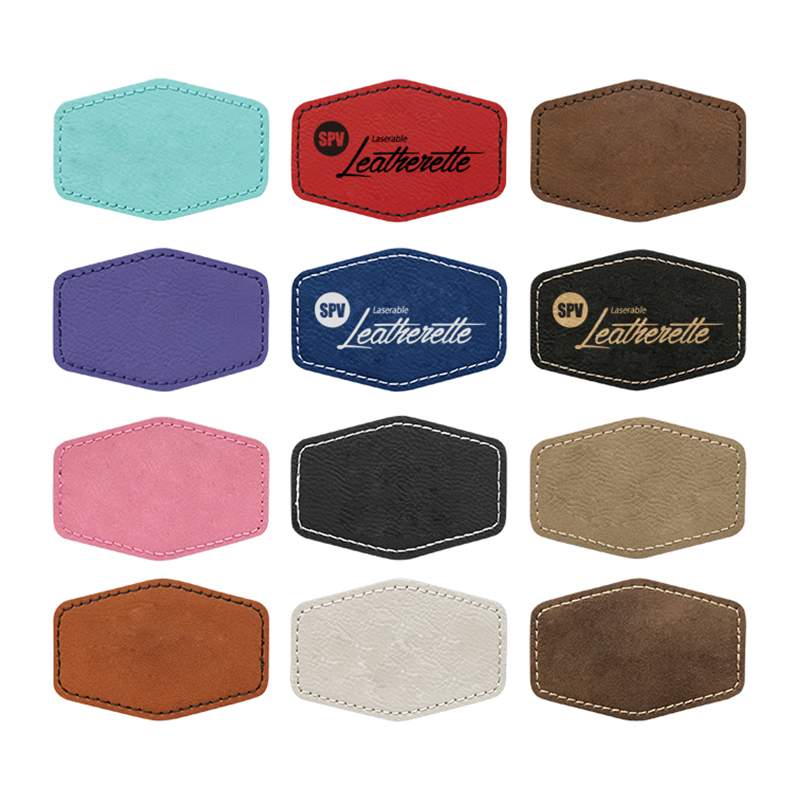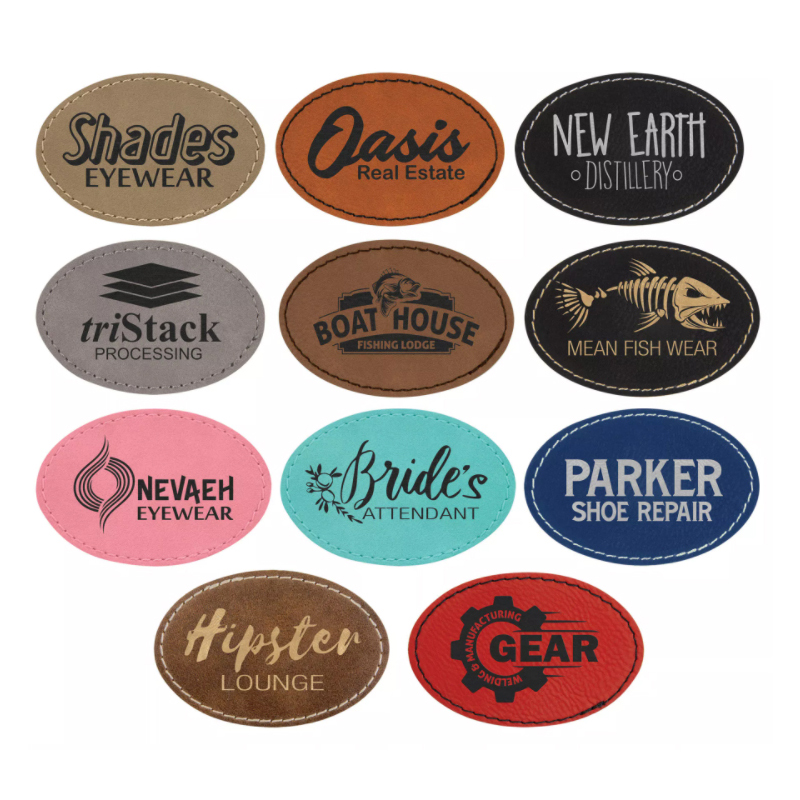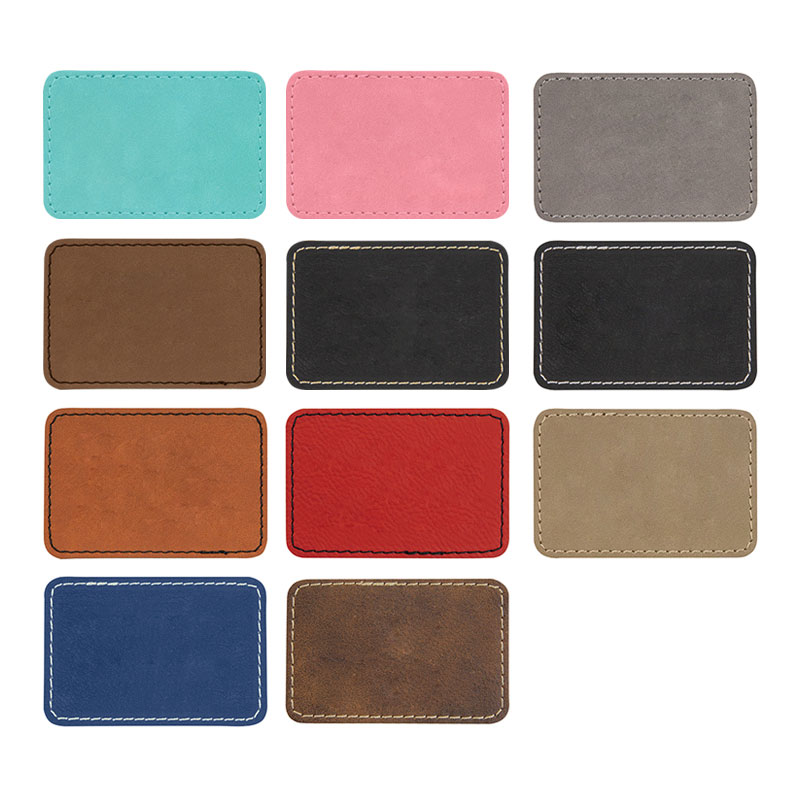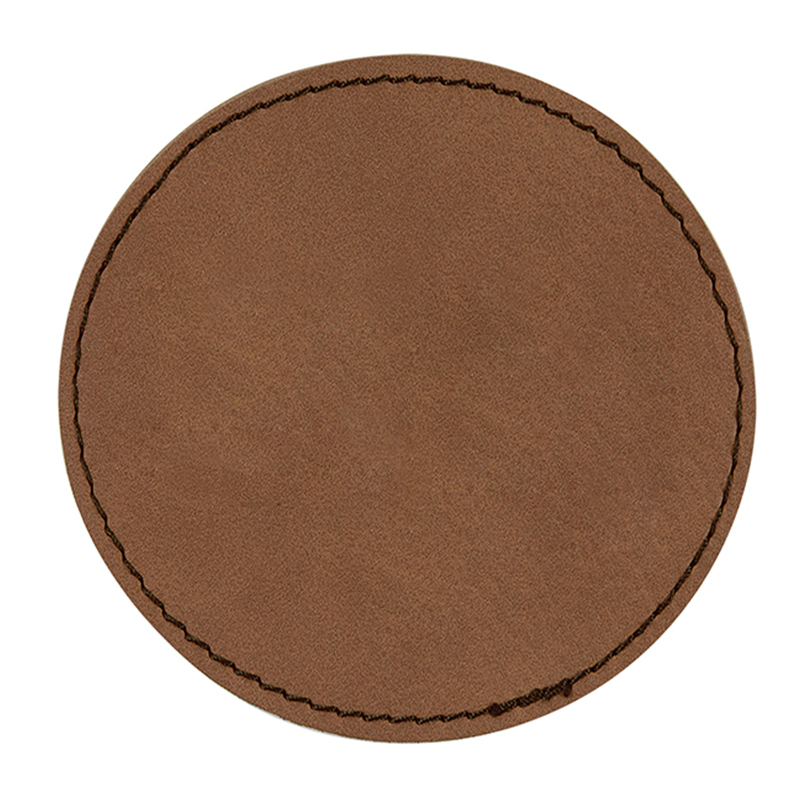Introduction of Leatherette Pet Collars Briefly introduce leatherette pet collars and their growing popularity. Leatherette pet collars have emerged as a dominant force in the pet ...
Read MoreLaser Engraved Leather vs Faux Leather Patches: Which is Best for Your Project?
2025-11-12Why Choose Laser Engraved Leather Patches for High-Quality Custom Designs?
When it comes to custom designs for fashion, branding, and accessories, the materials you choose play a crucial role in defining the quality and longevity of the final product. One of the most popular and reliable options for these types of designs are laser engraved leather patches. These patches offer a unique combination of durability, versatility, and sophistication that many other materials simply cannot match. In this section, we’ll explore why laser engraved leather patches are the ideal choice for high-quality custom designs, comparing them to other alternatives and examining their key benefits.
Unmatched Precision and Detail in Laser Engraving
One of the primary reasons to choose laser engraved leather patches is the exceptional precision they offer. Laser engraving uses highly focused laser beams to etch designs into the leather material. This process allows for extremely fine lines, intricate patterns, and detailed logos that other methods, such as screen printing or embroidery, might struggle to replicate.
Laser technology can carve out tiny, complex details with an accuracy that would be difficult to achieve manually. Whether it’s a detailed company logo, intricate artwork, or personalized text, laser engraving ensures that every element is crisp and sharp, which is crucial for maintaining the integrity of the design on the leather surface.
This level of detail is especially important for brands that want to make a lasting impression. A highly detailed logo or design on a leather patch conveys professionalism and attention to detail, which enhances the perceived value of the product. It’s this combination of precision and consistency that makes laser engraved leather patches an excellent choice for businesses looking to elevate their brand image.
Durability and Longevity of Laser Engraved Leather Patches
Another significant advantage of choosing laser engraved leather patches for custom designs is their incredible durability. Unlike other materials that may fade, wear down, or lose their quality over time, leather (whether genuine or faux) is naturally durable, flexible, and resistant to damage.
When designs are laser engraved onto the leather, the process does not just sit on top of the material like a printed ink or thread. Instead, the design is etched into the leather’s surface. This creates a permanent marking that will not rub off, fade, or peel over time, even with exposure to the elements. For example, items like jackets, bags, or hats that are regularly handled or exposed to outdoor conditions will retain their design quality much longer when made with laser engraved leather patches.
Additionally, leather itself, especially genuine leather and high-quality faux leather, ages beautifully over time, developing a unique patina. This means that laser engraved leather patches will become even more visually appealing as the material matures. Whether the patch is part of a luxury handbag or a sports team jacket, the high durability of the leather ensures that the custom design remains intact for the long haul, enhancing the lifespan of the product.
Versatility in Application and Design Options
Laser engraved leather patches are incredibly versatile in terms of design, shape, and application. Unlike embroidered patches, which are limited by thread count and thickness, laser engraving can handle a wide range of materials and design specifications. Whether you are working with genuine leather, faux leather, or even recycled leather, the laser engraving process can be adapted to suit your needs.
Custom Shapes and Sizes
Laser engraving allows for complete customization in terms of the size and shape of your patches. There is no need to work within the constraints of a predefined design template. You can create patches that are round, square, or custom-cut to match the unique look of your product. Additionally, complex cuts like cut-out patterns or geometric shapes can be done with precision that wouldn’t be possible with manual cutting or other traditional methods.
Incorporating Multiple Design Elements
Laser engraving also allows for a combination of design elements, including logos, artwork, text, and even images. For example, a brand could incorporate its name and slogan into the design, along with an intricate illustration or artwork, all on the same patch. Unlike traditional methods such as embroidery, where adding multiple design layers can increase cost and complexity, laser engraving can handle multiple components in a single, seamless process.
This versatility makes laser engraved leather patches ideal for a variety of industries, including fashion, sports, corporate branding, and personalized gifts. Whether you're looking to create unique jackets for a fashion line, personalized leather wallets, or custom patches for a sports team, laser engraving offers the design flexibility needed to bring your ideas to life.
Eco-Friendly and Sustainable Option
In today’s environmentally conscious market, sustainability is an increasingly important consideration for consumers. When choosing custom materials, many businesses are turning to eco-friendly options, and laser engraved leather patches provide an excellent solution in this regard.
Sustainable Materials
By choosing high-quality faux leather or recycled leather, businesses can reduce their environmental impact while still achieving the high-end look and feel of traditional leather. Faux leather is made from synthetic materials that replicate the look of genuine leather without using animal products. This makes it an ideal option for consumers who prefer cruelty-free alternatives.
Minimal Waste Process
The laser engraving process itself is incredibly efficient, generating minimal waste. Unlike methods that involve excessive ink, dyes, or thread, laser engraving only removes small amounts of material to create the design. This precision means there is very little material loss, making it a more sustainable choice compared to other customization techniques.
Moreover, laser engraving does not require harmful chemicals or solvents that are often used in traditional printing processes. It also produces no waste that could end up in landfills, contributing to a more eco-conscious production cycle.
By using laser engraved leather patches, businesses can meet consumer demand for sustainable products while still offering premium quality and exceptional designs.
Affordable Customization Without Sacrificing Quality
One of the most appealing aspects of laser engraved leather patches is their cost-effectiveness when compared to other methods like embroidery or screen printing. While custom embroidered patches may require significant setup costs and manual labor, laser engraving offers a more streamlined, automated process that results in lower labor costs.
Lower Setup and Production Costs
Unlike embroidery, which involves digitizing the design, creating stitch patterns, and physically stitching the design onto the material, laser engraving requires minimal setup. Once the design file is prepared, the engraving process is quick and efficient, reducing both the time and cost per unit. As a result, businesses can produce high-quality custom leather patches at a fraction of the cost compared to traditional methods, making it an ideal choice for both small batch and large-scale production.
No Hidden Costs
Another advantage of laser engraving is that there are no hidden or unexpected costs during production. Embroidery may require additional materials like threads or backing, and screen printing may need special inks or treatments, adding complexity and hidden costs. In contrast, laser engraving requires only the leather and the engraving process, with no additional materials or steps to worry about.
Perfect for Branding and Personalization
Finally, laser engraved leather patches are an excellent choice for brands looking to personalize their products. Whether you’re looking to add a custom logo to a fashion accessory, branded merchandise, or corporate gifts, laser engraved patches create a professional, polished appearance that conveys quality and attention to detail.
Many businesses use laser engraved patches to add their logos or slogans to promotional items, such as leather wallets, keychains, or backpacks. This method of customization not only enhances the look of the product but also helps in building brand recognition. Personalized designs using laser engraving are far more noticeable and professional compared to traditional fabric patches or iron-ons.
Laser engraved leather patches are also highly customizable, offering the flexibility to add individual names, initials, or other personalized elements, making them ideal for gifts or premium product lines.
Laser Engraved Leather Patches vs Faux Leather: Durability Comparison
When it comes to creating durable and long-lasting custom designs for fashion, accessories, or branding, the choice of material is one of the most important considerations. Two popular options for creating high-quality patches are laser engraved leather patches and faux leather patches. Both materials are widely used for a range of applications, but they have distinct characteristics when it comes to durability. In this section, we will conduct an in-depth comparison between laser engraved leather patches and faux leather patches, focusing on their respective durability, longevity, and performance over time.
The Durability of Laser Engraved Leather Patches
Laser engraved leather patches are widely recognized for their superior durability, making them an excellent choice for products that undergo heavy use or exposure to harsh conditions. Whether the patches are applied to clothing, bags, footwear, or other accessories, their longevity is a key factor in maintaining the aesthetic appeal and integrity of the product.
Leather: A Natural, Long-Lasting Material
Leather, especially genuine leather, is one of the most durable materials available for making custom patches. The natural fibers of leather provide a tough, resilient structure that can withstand significant wear and tear. Over time, genuine leather develops a patina—a natural aging process that enhances its aesthetic appeal and makes the material even more resilient to damage. This makes laser engraved leather patches an ideal choice for products that need to maintain their quality over the years, such as luxury handbags, jackets, and boots.
When laser engraving is applied to genuine leather, the process ensures that the design is permanently etched into the material. This engraving is not a surface treatment but rather a deep etching, which means that it will not fade, rub off, or peel over time. Even in conditions where the leather is subjected to frequent handling, moisture, or friction, the engraved design will remain intact, offering lasting visibility and durability.
Resistance to Wear and Friction
Leather is naturally resistant to abrasion and wear caused by friction. For example, a leather patch on a high-contact area like the elbow of a jacket or a pocket on a bag is likely to last much longer than similar patches made from other materials. Laser engraved leather patches can endure these high-friction areas because the material itself is tough and the engraving is a part of the leather, not just a surface coating that can be worn off.
Furthermore, leather has an innate ability to breathe and flex. Unlike synthetic materials, leather will not crack or stiffen when exposed to constant bending or stretching. This makes it a perfect material for patches that need to move with the fabric (such as on clothing) while retaining their appearance and durability.
Weather and Environmental Resistance
Leather is naturally water-resistant to some degree, and when treated correctly, it can offer significant resistance to moisture, humidity, and temperature changes. While prolonged exposure to rain or water can damage untreated leather, laser engraved leather patches on high-quality leather are more resilient to these elements than most other materials, including faux leather.
In addition to moisture resistance, leather is also resistant to UV damage. Direct sunlight can cause fading and deterioration in many materials, but genuine leather tends to age beautifully with exposure to light, rather than degrade quickly. Over time, laser engraved leather will develop a unique texture and color, which adds to the charm and character of the item.
Maintenance and Care
While leather is durable, it does require proper care to maintain its longevity. Regular cleaning, conditioning, and protection from extreme conditions are essential to keeping the leather looking its best. However, with the correct maintenance, laser engraved leather patches can retain their aesthetic and structural integrity for many years, even decades.
The Durability of Faux Leather Patches
Faux leather, also known as synthetic leather or leatherette, is made from petroleum-based products or other synthetic materials designed to mimic the look and feel of real leather. While faux leather can be a cost-effective and animal-friendly alternative to genuine leather, its durability is often not as high as that of natural leather. This section will discuss the durability aspects of faux leather and how it compares to laser engraved leather patches.
Lower Resistance to Abrasive Wear
Faux leather is generally less durable than genuine leather in terms of its ability to withstand abrasive wear. Unlike real leather, which is composed of fibrous natural material, faux leather is typically made from plastics or polyurethane (PU) coatings applied to a fabric backing. While this construction allows faux leather to look similar to the real thing, it lacks the inherent strength and flexibility of natural leather fibers.
As a result, faux leather patches are more likely to wear down or show signs of damage after prolonged exposure to high-friction areas. This is particularly true for items that experience a lot of movement or rubbing, such as bags, wallets, or clothing. The surface of faux leather is prone to cracking or peeling when subjected to repeated friction, especially in areas where the material is bent or stretched regularly.
Faux leather patches may also lose their shape over time and are more prone to cracking at the edges if they are not maintained properly. This is a significant downside when compared to the durability of laser engraved leather patches, which maintain their integrity over the long term due to the material’s natural composition.
Moisture and Weather Resistance
Faux leather is generally less resistant to water and moisture than genuine leather. While faux leather may be water-resistant to some degree, it is much more susceptible to damage from exposure to water. Prolonged exposure to moisture can cause the material to warp, crack, or lose its shape.
Faux leather is highly vulnerable to UV damage. Over time, direct exposure to sunlight can cause the material to fade, deteriorate, and lose its glossy finish. Unlike leather, which develops a patina and improves in appearance with age, faux leather tends to deteriorate in quality after prolonged sun exposure or moisture contact. This makes faux leather patches less suitable for outdoor products or items exposed to harsh environmental conditions.
Maintenance and Longevity of Faux Leather
Faux leather requires more frequent maintenance compared to laser engraved leather patches. It needs to be cleaned regularly to prevent the surface from looking dull or worn, and it is more prone to showing signs of damage from everyday wear and tear. When faux leather begins to peel or crack, the damage is usually irreversible. This means that faux leather patches may not last as long as leather patches, especially when subjected to the kind of treatment and usage that laser engraved leather patches can handle without degradation.
While faux leather is a low-maintenance material compared to real leather (since it does not require conditioning or regular care), its overall durability is significantly lower. Faux leather products tend to have a shorter lifespan, and their appearance can degrade much faster than genuine leather.
How Laser Engraved Leather Patches Enhance the Aesthetic of Your Products
In today’s competitive market, aesthetics play a vital role in the success of any product. Whether you’re in the fashion industry, corporate branding, or creating personalized gifts, how a product looks can make a lasting impression on consumers. Laser engraved leather patches offer an exceptional way to enhance the visual appeal and overall quality of a product. The process of laser engraving is precise, detailed, and permanent, adding an elegant touch to products ranging from jackets to bags, accessories, and more. In this section, we will explore how laser engraved leather patches can elevate the aesthetic of your products, focusing on their visual appeal, versatility, ability to reflect brand identity, and how they contribute to a sense of craftsmanship and luxury.
Precise and Intricate Detailing for a Refined Look
One of the most compelling reasons to choose laser engraved leather patches is their ability to capture intricate designs with an unmatched level of precision. The process of laser engraving uses highly focused beams of light to etch designs directly into the leather, which results in a clean, sharp, and detailed aesthetic that cannot be replicated through traditional methods like embroidery or printing.
Fine Lines and Complex Designs
Laser engraving excels at creating fine lines and detailed patterns that are simply impossible to achieve with embroidery or screen printing. Whether it’s a company logo, a custom illustration, or a complex geometric pattern, laser engraving enables the designer to include minute details in the design without sacrificing clarity. This level of intricacy adds sophistication to any product, making the design appear more professional and premium.
For instance, a small floral design, personalized initials, or custom brand logo can be rendered in great detail, ensuring that even the smallest elements are crisp and legible. This precision elevates the overall aesthetic of the product, making it stand out from competitors that may rely on more basic design methods.
No Threading or Ink Buildup
Unlike embroidery or printing, which rely on thread or ink that can sometimes appear bulky or uneven, laser engraved leather patches retain the clean, natural look of the leather. The engraving process does not add any additional material on top of the leather surface, meaning the design becomes an integral part of the leather itself. This ensures that the patch maintains a sleek, minimalist appearance, which complements modern and luxury products alike.
Because laser engraving is precise, it creates designs that appear part of the leather, rather than simply “added on.” The result is a design that feels organic and high-end, giving the product a more refined, timeless quality that enhances its overall aesthetic.
Versatility in Customization for Every Style
Laser engraved leather patches are incredibly versatile, and this versatility can greatly enhance the aesthetic appeal of your products. Whether your brand leans towards minimalism, bohemian, luxury, or vintage design aesthetics, laser engraved leather patches can be customized to reflect your vision in the most authentic way.
Match Your Brand’s Identity
One of the most important ways a laser engraved leather patch can enhance your product’s aesthetic is through its ability to reflect the identity of the brand or the individual. Custom logos, monograms, or designs that resonate with a brand’s core values and image can be meticulously etched into the leather. The versatility of laser engraving allows for the size, shape, and complexity of the patch to be adjusted according to the product, whether it’s a large patch on a jacket or a small, delicate emblem on a wallet.
Laser engraving also allows for designs to be more tailored and personalized, making the product more meaningful to the customer. For example, a leather tote bag with a personalized engraved patch can reflect the individuality of the customer, giving the product a one-of-a-kind appeal. For luxury brands, using laser engraved leather patches to feature a distinct logo or highly detailed graphic reinforces the exclusivity and high-end status of the product.
Complementing Different Product Styles
Laser engraved leather patches can be used to enhance a variety of product styles. In the fashion industry, leather patches can add vintage charm to denim jackets or rustic elegance to leather bags, backpacks, and boots. For a more modern and sleek look, laser engraved patches can be kept minimalistic, with simple, clean lines and geometric shapes. In contrast, for products aiming for a more artisanal or bohemian aesthetic, laser engraved patches can feature intricate, organic designs, such as nature motifs or ethnic patterns, that stand out and reflect a unique personality.
The ability to adapt the design based on the product’s style gives laser engraved leather patches the ability to enhance the overall product aesthetic, making it more cohesive with the rest of the design elements, from fabric choice to color palette.
The Luxurious Appeal of Leather
When it comes to creating products that communicate luxury, elegance, and timelessness, leather is a material that is often associated with high-end quality. By choosing laser engraved leather patches, you elevate your product's perceived value, transforming it from an ordinary item into something that feels premium and exclusive.
Leather’s Natural Beauty
Leather, especially genuine leather, has a natural grain and texture that adds depth and richness to any product. When you apply a laser engraved leather patch, the design interacts beautifully with the inherent qualities of the material. The subtle contrast between the natural color of the leather and the dark etched design makes the patch stand out, yet still retains an understated elegance. This natural look is often associated with luxury and fine craftsmanship.
Over time, leather develops a unique patina—a natural aging process that enhances its beauty and character. This means that laser engraved leather patches will only become more visually appealing as the product ages, creating a deepening richness in both color and texture. The more the leather is used and exposed to the elements, the more its appearance improves, making it look authentically lived-in and luxurious.
Timeless Design
The process of laser engraving offers a timeless quality to the design. Unlike other methods, such as printing or embroidery, which may fade, fray, or peel over time, laser engraving is permanent and does not lose its sharpness or clarity. This ensures that the design remains intact for years to come, adding lasting value to the product. For consumers, this long-lasting quality enhances the perception of value and craftsmanship, contributing to a luxury experience when using the product.
Texture and Dimension That Adds Depth
Laser engraved leather patches offer not only visual beauty but also an added textural dimension to a product’s surface. This is especially valuable for products that aim to evoke a sense of depth, craftsmanship, and artistry.
Tactile Appeal
Laser engraving goes beyond just creating a visual design; it also provides a tactile experience. The engraved area of the patch has a subtle raised texture that can be felt when running your fingers over it. This textural contrast adds a sensory layer to the product that enhances the overall user experience. A product with a leather patch that has both engraved details and smooth leather creates a tactile contrast that invites touch and interaction, giving the item a more premium feel.
Three-Dimensional Effect
Because laser engraving removes a small amount of material from the leather, the etched design often takes on a slightly three-dimensional effect. The depth of the engraving creates shadows and highlights within the design, adding a sense of dimension and movement. This depth effect makes the patch visually dynamic, allowing it to catch light from different angles, which enhances its overall presence on the product.
Creating a Unique, Personalized Aesthetic
Laser engraved leather patches also play a pivotal role in creating personalized products that resonate with consumers on an emotional level. Customization is an increasingly important factor in product aesthetics, as people are looking for items that reflect their individuality and identity.
Personalized Patches for Exclusive Products
Whether it’s for a luxury handbag, a sports team jacket, or a personalized gift, laser engraved leather patches provide an excellent platform for creating unique, one-of-a-kind designs. Consumers appreciate products that feature their names, initials, or personal messages engraved onto them. This kind of personalization not only enhances the aesthetic appeal of the product but also fosters a deeper connection with the consumer.
For businesses, offering personalized laser engraved leather patches adds a level of exclusivity and customization that can set your product apart in the marketplace. It’s no longer just about mass production; it’s about creating something that feels special, crafted for the individual, and uniquely theirs.
Laser Engraved Leather Patches: A Sustainable Option Compared to Faux Leather
Sustainability is no longer just a buzzword—it’s a key consideration in every aspect of product design, from sourcing materials to the impact on the environment over a product’s lifecycle. As consumers and businesses alike become more environmentally conscious, there has been a growing demand for sustainable options in fashion and branding. Laser engraved leather patches have emerged as a highly sustainable option, offering an eco-friendly alternative to synthetic materials like faux leather. In this section, we will explore the sustainability benefits of laser engraved leather patches, comparing them to faux leather in terms of environmental impact, longevity, material sourcing, and biodegradability.
Material Sourcing: Natural vs. Synthetic
Genuine Leather and Its Natural Origins
The core component of laser engraved leather patches is genuine leather, which is made from the hides of animals, typically cows. Leather is a natural material, and when responsibly sourced, it can be considered a renewable resource. Leather production, when managed ethically and sustainably, often uses by-products from the food industry, thus reducing waste. Leather is a durable material that has been used for centuries due to its inherent strength and longevity. As an organic material, leather is biodegradable, meaning it will break down over time without causing harm to the environment when disposed of properly.
While leather production does require significant resources, particularly water and energy, there are growing efforts within the industry to reduce the environmental impact of tanning and processing. Sustainable leather options include leather sourced from farms that prioritize ethical practices and minimize chemical use during tanning. There is also an increasing focus on vegetable tanning, a natural process that avoids toxic chemicals and uses renewable resources like plant-based tannins.
Faux Leather and Its Environmental Footprint
Faux leather, often made from synthetic polymers such as polyurethane (PU) or polyvinyl chloride (PVC), is an imitation of natural leather. While faux leather may initially seem like a greener alternative due to the absence of animal products, it presents significant environmental challenges. Unlike leather, faux leather is derived from non-renewable fossil fuels, making its production more resource-intensive. The production of faux leather relies on chemicals and processes that are often harmful to the environment, such as the use of plasticizers, solvents, and other synthetic chemicals that can contaminate waterways and soil.
In addition, the carbon footprint of faux leather production is considerably higher than that of genuine leather, as it involves significant energy consumption and oil-based raw materials. Faux leather is also not biodegradable, meaning that when it is disposed of, it can remain in landfills for hundreds of years without breaking down. Some faux leather materials, such as those made from PVC, release toxic chemicals into the environment during both production and disposal, further contributing to environmental degradation.
Longevity and Durability: Reducing Waste Over Time
Leather’s Durability and Longevity
One of the key sustainability advantages of laser engraved leather patches is their longevity. Leather is a highly durable material that can last for decades with proper care. Items made with genuine leather, such as jackets, bags, or footwear, often improve with age, developing a unique patina that adds character and beauty to the material. Because of this durability, leather products do not need to be replaced frequently, reducing the overall consumption of resources and minimizing waste.
In addition, leather’s inherent strength and resistance to wear and tear mean that laser engraved leather patches maintain their aesthetic and functional integrity even after years of use. This long-lasting nature helps contribute to the sustainability of leather products, as consumers do not have to purchase replacements as often. When leather products reach the end of their life cycle, they can also be recycled or upcycled into new products, ensuring that they do not contribute to the growing global waste crisis.
Faux Leather and Its Short Lifespan
In contrast, faux leather is much less durable than genuine leather. While it may look similar to real leather when new, it is more prone to cracking, peeling, and wearing out over time. Faux leather products, especially those that undergo frequent use or exposure to sunlight, often degrade more quickly than leather, leading to the need for replacement. This shorter lifespan results in a higher turnover rate for faux leather goods, contributing to increased consumption and waste.
The relatively short lifespan of faux leather means that products made from it are often discarded sooner than leather goods, contributing to greater waste accumulation in landfills. Because faux leather is typically made from synthetic plastics that do not biodegrade, these discarded items can remain in landfills for decades. The high turnover rate of faux leather products also drives the demand for new materials, further exacerbating resource depletion and environmental pollution.
Biodegradability and Waste Management
Leather’s Biodegradability
One of the primary reasons laser engraved leather patches are considered a sustainable option is that leather is a biodegradable material. When disposed of properly, genuine leather will naturally break down over time. The process of biodegradation involves the breaking down of organic materials by microorganisms such as bacteria and fungi. Leather products, when exposed to the right conditions, will decompose and return to the earth without releasing harmful toxins or pollutants into the environment.
Although the process of tanning leather requires certain chemicals, there are sustainable tanning methods, such as vegetable tanning, that use plant-based tannins and are less harmful to the environment. Even though leather requires more time to biodegrade than other natural materials like cotton, it still breaks down relatively quickly compared to synthetic alternatives like faux leather.
Faux Leather’s Environmental Impact
On the other hand, faux leather is not biodegradable. Faux leather products, especially those made from PVC or PU, can take hundreds of years to decompose. While the material may break down over time into smaller pieces, it typically does so in a way that releases harmful chemicals into the environment, making it highly damaging to ecosystems.
The non-biodegradable nature of faux leather contributes significantly to the global waste crisis, as it accumulates in landfills without breaking down. Additionally, the chemicals used in the production of faux leather, such as phthalates and volatile organic compounds (VOCs), can leach into the environment when the material is disposed of improperly, contaminating soil and water systems.
Faux leather’s long decomposition time and environmental toxicity make it a less sustainable option when compared to laser engraved leather patches, which can break down naturally and without causing harm.
Energy and Water Consumption in the Production Process
Leather’s Energy and Water Use
While the production of genuine leather requires significant energy and water, sustainable practices are being adopted to mitigate these impacts. The tanning process, for example, can be water-intensive, but modern technologies are evolving to use water more efficiently. Many leather manufacturers are transitioning to closed-loop systems, where water is recycled during production, and energy-efficient machinery is used to reduce emissions.
Leather’s durability means that products do not need to be produced as frequently, reducing the cumulative energy and water consumption over the product’s lifespan. This long-term efficiency contrasts with the shorter lifespan of faux leather, which results in more frequent production cycles and, ultimately, more resource consumption.
Faux Leather’s Resource-Intensive Production
In contrast, the production of faux leather is heavily reliant on fossil fuels, and it requires significant energy to convert petroleum-based raw materials into finished products. Faux leather also involves the use of harmful chemicals that must be processed and disposed of carefully to avoid environmental contamination. The energy consumption associated with faux leather production is higher than that of natural leather, as it involves synthetic polymer manufacturing that requires both energy and chemical inputs.
Faux leather is often made from polyurethane (PU) or polyvinyl chloride (PVC), both of which have a much larger environmental footprint than leather. These materials are derived from non-renewable resources, meaning they further contribute to fossil fuel depletion. Additionally, the water usage for synthetic material production is often less transparent than that of leather, but its environmental impact is significant, especially considering the amount of waste generated from manufacturing faux leather products.
Consumer Perception and Eco-Friendly Branding
The Growing Demand for Sustainable Materials
As consumers become more aware of the environmental consequences of their purchasing decisions, there is a significant shift toward eco-friendly products. Many buyers now look for items that are crafted from sustainable materials and that reflect an ethical approach to manufacturing. By choosing laser engraved leather patches, businesses can position themselves as eco-conscious and responsible producers, aligning with the growing trend of sustainable fashion and green branding.
Brands that use genuine leather, particularly when sourced responsibly, can highlight their commitment to environmentally sustainable practices. By focusing on leather’s natural and biodegradable qualities, they appeal to consumers who are concerned about the impact of their purchases. Moreover, laser engraving allows for a precise and low-impact method of adding designs to leather, which further reduces the environmental footprint compared to other more chemical-heavy processes like screen printing or embroidery.
Faux Leather’s Negative Environmental Connotations
While faux leather may initially appeal to consumers seeking cruelty-free options, it is becoming increasingly clear that its environmental drawbacks are hard to ignore. As more consumers seek to make eco-conscious purchases, faux leather is beginning to face growing scrutiny due to its synthetic origins and long-lasting environmental impact.
By choosing laser engraved leather patches over faux leather, businesses not only embrace the authenticity and natural beauty of leather, but also send a powerful message about their commitment to sustainability. Consumers are more likely to align with brands that prioritize both environmental responsibility and craftsmanship, which is increasingly seen as the future of fashion and branding.
Contact Us
Your email address will not be published. Required field are marked*
-
-
Why Choose Laser Engraved Leather Patches for High-Quality Custom Designs? When it comes to custom designs for fashion, branding, and accessories, the materials you choose play a c...
Read More -
Introduction to Laserable Leatherette What Is Laserable Leatherette? Laserable leatherette refers to a type of leatherette material engineered to respond well to laser processing, ...
Read More -
Unveiling the World of Leatherette Coasters: Beyond Basic Tableware Defining the Coaster: An Essential Home Accessory Before delving into the unique advantages of Leatherette Coast...
Read More






 English
English  Español
Español  Deutsch
Deutsch 